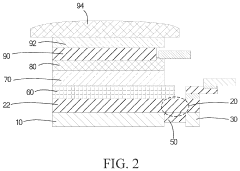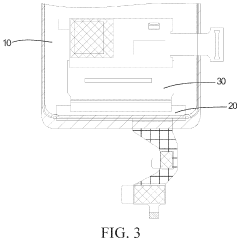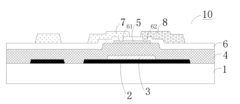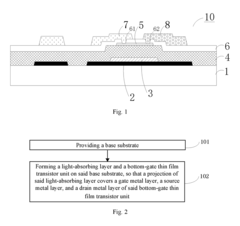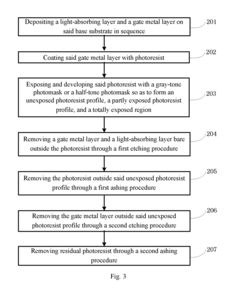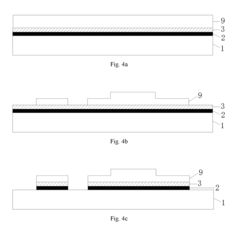How AMOLED inspires breakthroughs in transparent electronics?
JUL 17, 20259 MIN READ
Generate Your Research Report Instantly with AI Agent
Patsnap Eureka helps you evaluate technical feasibility & market potential.
AMOLED Evolution and Transparent Electronics Goals
The evolution of AMOLED (Active-Matrix Organic Light-Emitting Diode) technology has been a driving force behind the recent advancements in transparent electronics. This synergy between AMOLED and transparent electronics aims to create innovative display solutions that seamlessly integrate into our environment while offering superior visual performance.
AMOLED technology has progressed significantly since its inception, with key milestones including improved color accuracy, enhanced energy efficiency, and increased flexibility. The development of transparent AMOLED displays represents a natural progression in this technological journey, pushing the boundaries of what is possible in display technology.
The primary goal of transparent electronics, inspired by AMOLED breakthroughs, is to create fully functional electronic devices that are visually unobtrusive and can be seamlessly integrated into everyday objects. This includes transparent displays, sensors, and circuits that can be incorporated into windows, eyewear, and other surfaces without compromising visibility or aesthetics.
One of the key objectives in this field is to achieve high transparency while maintaining excellent display performance. AMOLED's self-emissive nature and ability to produce vibrant colors even in thin form factors make it an ideal candidate for transparent display applications. Researchers and engineers are working towards increasing the transparency of AMOLED panels while preserving their superior contrast ratios and color reproduction capabilities.
Another important goal is to enhance the durability and flexibility of transparent electronic components. AMOLED's inherent flexibility has inspired the development of bendable and foldable transparent displays, which could revolutionize the design of wearable devices and smart surfaces. The challenge lies in creating transparent electronic materials that can withstand repeated bending and environmental stresses without degrading performance.
Energy efficiency is a crucial consideration in the development of transparent electronics. AMOLED's low power consumption characteristics have set a benchmark for transparent display technologies. The aim is to create transparent electronic systems that can operate efficiently on limited power sources, making them suitable for a wide range of applications, from smart windows to augmented reality devices.
Lastly, the integration of transparent electronics with other emerging technologies, such as touch sensors and energy harvesting systems, is a key objective. The goal is to create multifunctional transparent devices that can interact with users and the environment while generating their own power, paving the way for truly ubiquitous and sustainable transparent electronics.
AMOLED technology has progressed significantly since its inception, with key milestones including improved color accuracy, enhanced energy efficiency, and increased flexibility. The development of transparent AMOLED displays represents a natural progression in this technological journey, pushing the boundaries of what is possible in display technology.
The primary goal of transparent electronics, inspired by AMOLED breakthroughs, is to create fully functional electronic devices that are visually unobtrusive and can be seamlessly integrated into everyday objects. This includes transparent displays, sensors, and circuits that can be incorporated into windows, eyewear, and other surfaces without compromising visibility or aesthetics.
One of the key objectives in this field is to achieve high transparency while maintaining excellent display performance. AMOLED's self-emissive nature and ability to produce vibrant colors even in thin form factors make it an ideal candidate for transparent display applications. Researchers and engineers are working towards increasing the transparency of AMOLED panels while preserving their superior contrast ratios and color reproduction capabilities.
Another important goal is to enhance the durability and flexibility of transparent electronic components. AMOLED's inherent flexibility has inspired the development of bendable and foldable transparent displays, which could revolutionize the design of wearable devices and smart surfaces. The challenge lies in creating transparent electronic materials that can withstand repeated bending and environmental stresses without degrading performance.
Energy efficiency is a crucial consideration in the development of transparent electronics. AMOLED's low power consumption characteristics have set a benchmark for transparent display technologies. The aim is to create transparent electronic systems that can operate efficiently on limited power sources, making them suitable for a wide range of applications, from smart windows to augmented reality devices.
Lastly, the integration of transparent electronics with other emerging technologies, such as touch sensors and energy harvesting systems, is a key objective. The goal is to create multifunctional transparent devices that can interact with users and the environment while generating their own power, paving the way for truly ubiquitous and sustainable transparent electronics.
Market Demand for Transparent Electronic Devices
The market demand for transparent electronic devices has been steadily growing, driven by advancements in display technologies and the increasing need for innovative, futuristic products. This demand spans across various sectors, including consumer electronics, automotive, healthcare, and smart home applications. The integration of AMOLED technology with transparent electronics has opened up new possibilities, fueling market interest and potential growth.
In the consumer electronics sector, there is a rising demand for transparent smartphones, tablets, and wearable devices. These products offer unique user experiences, blending digital interfaces seamlessly with the physical environment. The automotive industry has shown significant interest in transparent displays for windshields and windows, enhancing driver safety and providing augmented reality navigation. This application alone is expected to drive substantial market growth in the coming years.
The healthcare sector presents another promising market for transparent electronic devices. Transparent displays in medical equipment, such as surgical monitors and patient information systems, can improve workflow efficiency and patient care. Smart home applications, including transparent televisions and smart mirrors, are gaining traction among tech-savvy consumers seeking cutting-edge home entertainment and information systems.
Retail and advertising industries are also exploring the potential of transparent displays for interactive storefronts and immersive marketing experiences. This trend is likely to contribute to the overall market expansion for transparent electronic devices.
The market demand is further bolstered by the increasing focus on energy efficiency and sustainability. Transparent electronic devices, particularly those inspired by AMOLED technology, offer the potential for reduced power consumption and improved durability compared to traditional display technologies.
However, challenges such as high production costs and technical limitations in achieving full transparency while maintaining optimal performance currently restrict widespread adoption. As research and development efforts continue to address these issues, the market is expected to witness accelerated growth.
Geographically, Asia-Pacific region, particularly countries like South Korea, Japan, and China, leads in both production and adoption of transparent electronic devices. North America and Europe follow closely, with strong demand in automotive and consumer electronics sectors.
As the technology matures and becomes more accessible, the market for transparent electronic devices is projected to expand significantly. The convergence of AMOLED technology with transparent electronics is likely to play a crucial role in shaping this market, driving innovation and creating new application possibilities across various industries.
In the consumer electronics sector, there is a rising demand for transparent smartphones, tablets, and wearable devices. These products offer unique user experiences, blending digital interfaces seamlessly with the physical environment. The automotive industry has shown significant interest in transparent displays for windshields and windows, enhancing driver safety and providing augmented reality navigation. This application alone is expected to drive substantial market growth in the coming years.
The healthcare sector presents another promising market for transparent electronic devices. Transparent displays in medical equipment, such as surgical monitors and patient information systems, can improve workflow efficiency and patient care. Smart home applications, including transparent televisions and smart mirrors, are gaining traction among tech-savvy consumers seeking cutting-edge home entertainment and information systems.
Retail and advertising industries are also exploring the potential of transparent displays for interactive storefronts and immersive marketing experiences. This trend is likely to contribute to the overall market expansion for transparent electronic devices.
The market demand is further bolstered by the increasing focus on energy efficiency and sustainability. Transparent electronic devices, particularly those inspired by AMOLED technology, offer the potential for reduced power consumption and improved durability compared to traditional display technologies.
However, challenges such as high production costs and technical limitations in achieving full transparency while maintaining optimal performance currently restrict widespread adoption. As research and development efforts continue to address these issues, the market is expected to witness accelerated growth.
Geographically, Asia-Pacific region, particularly countries like South Korea, Japan, and China, leads in both production and adoption of transparent electronic devices. North America and Europe follow closely, with strong demand in automotive and consumer electronics sectors.
As the technology matures and becomes more accessible, the market for transparent electronic devices is projected to expand significantly. The convergence of AMOLED technology with transparent electronics is likely to play a crucial role in shaping this market, driving innovation and creating new application possibilities across various industries.
Current State of AMOLED and Transparent Electronics
AMOLED (Active-Matrix Organic Light-Emitting Diode) technology has revolutionized the display industry with its superior image quality, energy efficiency, and flexibility. Concurrently, transparent electronics have emerged as a promising field with applications in various sectors. The convergence of these two technologies is driving innovation and inspiring breakthroughs in transparent electronic devices.
AMOLED displays have reached a high level of maturity in the consumer electronics market, particularly in smartphones and televisions. They offer advantages such as vibrant colors, high contrast ratios, and wide viewing angles. The technology's ability to selectively illuminate pixels also contributes to its energy efficiency. Major manufacturers like Samsung and LG have invested heavily in AMOLED production, leading to improved yields and reduced costs.
In the realm of transparent electronics, significant progress has been made in developing transparent conductive materials, such as indium tin oxide (ITO) and graphene. These materials enable the creation of invisible circuits and electrodes, which are crucial for transparent displays and touch sensors. Researchers have also developed transparent thin-film transistors (TFTs) using materials like zinc oxide and indium gallium zinc oxide (IGZO), paving the way for fully transparent electronic devices.
The intersection of AMOLED and transparent electronics has led to the development of transparent OLED displays. These displays maintain the benefits of AMOLED technology while offering see-through capabilities. Companies like LG and Xiaomi have showcased prototype transparent OLED TVs and smartphones, demonstrating the potential for integrating displays into windows, windshields, and other transparent surfaces.
However, challenges remain in scaling up the production of transparent AMOLED displays. Issues such as lower light transmission compared to traditional glass, durability concerns, and high manufacturing costs need to be addressed. Additionally, the integration of transparent electronics with existing AMOLED fabrication processes requires further refinement to achieve commercial viability.
Recent advancements in materials science have opened up new possibilities for transparent electronics. The development of highly transparent and conductive nanomaterials, such as silver nanowires and carbon nanotubes, offers alternatives to traditional transparent conductors. These materials could potentially enhance the performance and flexibility of transparent AMOLED displays.
The current state of AMOLED and transparent electronics also sees increasing interest in flexible and stretchable devices. Researchers are exploring ways to combine the flexibility of AMOLED technology with transparent and stretchable substrates to create conformable displays that can be integrated into various surfaces and form factors.
AMOLED displays have reached a high level of maturity in the consumer electronics market, particularly in smartphones and televisions. They offer advantages such as vibrant colors, high contrast ratios, and wide viewing angles. The technology's ability to selectively illuminate pixels also contributes to its energy efficiency. Major manufacturers like Samsung and LG have invested heavily in AMOLED production, leading to improved yields and reduced costs.
In the realm of transparent electronics, significant progress has been made in developing transparent conductive materials, such as indium tin oxide (ITO) and graphene. These materials enable the creation of invisible circuits and electrodes, which are crucial for transparent displays and touch sensors. Researchers have also developed transparent thin-film transistors (TFTs) using materials like zinc oxide and indium gallium zinc oxide (IGZO), paving the way for fully transparent electronic devices.
The intersection of AMOLED and transparent electronics has led to the development of transparent OLED displays. These displays maintain the benefits of AMOLED technology while offering see-through capabilities. Companies like LG and Xiaomi have showcased prototype transparent OLED TVs and smartphones, demonstrating the potential for integrating displays into windows, windshields, and other transparent surfaces.
However, challenges remain in scaling up the production of transparent AMOLED displays. Issues such as lower light transmission compared to traditional glass, durability concerns, and high manufacturing costs need to be addressed. Additionally, the integration of transparent electronics with existing AMOLED fabrication processes requires further refinement to achieve commercial viability.
Recent advancements in materials science have opened up new possibilities for transparent electronics. The development of highly transparent and conductive nanomaterials, such as silver nanowires and carbon nanotubes, offers alternatives to traditional transparent conductors. These materials could potentially enhance the performance and flexibility of transparent AMOLED displays.
The current state of AMOLED and transparent electronics also sees increasing interest in flexible and stretchable devices. Researchers are exploring ways to combine the flexibility of AMOLED technology with transparent and stretchable substrates to create conformable displays that can be integrated into various surfaces and form factors.
Existing Transparent Electronics Solutions
01 Transparent AMOLED display structure
AMOLED displays can be designed with transparent structures, allowing light to pass through the display. This is achieved by using transparent electrodes, light-emitting layers, and substrate materials. The transparency enables see-through displays and augmented reality applications.- Transparent AMOLED display structure: AMOLED displays can be designed with transparent structures, allowing light to pass through the display. This is achieved by using transparent materials for electrodes, organic layers, and substrates. The design may include specific pixel arrangements and light-transmitting areas to enhance overall transparency while maintaining display quality.
- Pixel circuit design for transparent AMOLEDs: Specialized pixel circuits are developed for transparent AMOLED displays to optimize both display performance and transparency. These circuits may include transparent thin-film transistors, capacitors, and other components arranged to minimize light obstruction while ensuring proper pixel operation and control.
- Transparent electrode materials and fabrication: Development of transparent electrode materials is crucial for AMOLED transparency. This includes the use of materials like indium tin oxide (ITO), graphene, or metal nanowires. Advanced fabrication techniques are employed to create these electrodes with high conductivity and optical transparency.
- Light management techniques for transparent AMOLEDs: Various light management techniques are implemented to enhance the transparency and display quality of AMOLED screens. These may include anti-reflection coatings, micro-lens arrays, or specialized optical films to improve light transmission and reduce internal reflections.
- Integration of transparent AMOLEDs in devices: Transparent AMOLED displays are integrated into various devices such as smartphones, wearables, or automotive applications. This integration involves addressing challenges related to power consumption, durability, and compatibility with other device components while maintaining transparency.
02 Pixel circuit design for transparent AMOLEDs
Specialized pixel circuits are developed for transparent AMOLED displays. These circuits are designed to maintain display performance while allowing light transmission. They may include transparent thin-film transistors and optimized layouts to maximize the transparent area of each pixel.Expand Specific Solutions03 Transparent electrode materials
Development of transparent conductive materials for electrodes is crucial for AMOLED transparency. Materials such as indium tin oxide (ITO) and graphene are used to create electrodes that are both conductive and highly transparent, enabling light transmission through the display.Expand Specific Solutions04 Optical optimization for transparent AMOLEDs
Various optical optimization techniques are employed to enhance the transparency and display quality of AMOLED screens. These may include anti-reflection coatings, optical matching layers, and micro-lens arrays to improve light transmission and reduce internal reflections.Expand Specific Solutions05 Driving methods for transparent AMOLED displays
Specialized driving methods are developed for transparent AMOLED displays to maintain image quality and power efficiency while ensuring transparency. These methods may include adaptive brightness control, transparent mode switching, and optimized voltage/current control schemes.Expand Specific Solutions
Key Players in AMOLED and Transparent Electronics
The AMOLED technology market is in a growth phase, with increasing demand for transparent electronics driving innovation. The market size is expanding rapidly, fueled by applications in smartphones, wearables, and emerging transparent display sectors. Technologically, AMOLED is maturing but still evolving, particularly in transparent applications. Key players like BOE Technology, TCL China Star, and LG Display are leading development efforts, with companies such as Everdisplay Optronics and Visionox also making significant contributions. These firms are investing heavily in R&D to overcome challenges in transparency, flexibility, and durability, pushing the boundaries of AMOLED technology for next-generation transparent electronic devices.
BOE Technology Group Co., Ltd.
Technical Solution: BOE has made significant strides in AMOLED-inspired transparent electronics. They have developed a 55-inch transparent AMOLED display with a transmittance of up to 38%[1]. This technology utilizes a top-emission OLED structure with transparent cathodes, allowing light to pass through the display. BOE has also introduced flexible AMOLED displays that can be bent, folded, and rolled, incorporating transparent areas for augmented reality applications[2]. Their approach involves using indium tin oxide (ITO) as a transparent electrode material and optimizing the OLED stack to balance transparency and display performance[3].
Strengths: High transmittance, large-scale production capability, and integration of flexibility with transparency. Weaknesses: Potential color accuracy issues in transparent areas and higher production costs compared to traditional displays.
Everdisplay Optronics (Shanghai) Co., Ltd.
Technical Solution: Everdisplay has made progress in AMOLED-inspired transparent electronics, focusing on small and medium-sized displays for mobile devices and wearables. They have developed transparent AMOLED displays with a transmittance of up to 40% for smartwatch applications[11]. Their approach involves using a top-emission OLED structure with transparent cathodes and optimizing the OLED materials for improved light transmission. Everdisplay has also explored the integration of transparent AMOLED technology with flexible substrates, enabling curved and bendable transparent displays[12].
Strengths: Expertise in small form factor transparent displays, integration with flexible substrates. Weaknesses: Limited experience in large-scale transparent displays, potential challenges in scaling up production.
AMOLED Innovations for Transparent Applications
Active matrix organic light emitting diode panel
PatentInactiveUS20200185645A1
Innovation
- An AMOLED panel design featuring a hydrogel layer coated between two backing plates at the bent portion, which is then solidified with ultraviolet light, providing structural strength and toughness to the fillet formed when the panel is folded, thereby preventing deformation and breakage.
Array substrate, display device, and method for manufacturing array substrate
PatentActiveUS20170148862A1
Innovation
- An array substrate with a light-absorbing layer covering the gate, source, and drain metal layers of a bottom-gate thin film transistor unit, preventing ambient light irradiation while allowing useful light to pass through.
Materials Science Advancements for Transparent Displays
The field of transparent electronics has witnessed significant advancements in recent years, largely inspired by the success of AMOLED (Active-Matrix Organic Light-Emitting Diode) technology. These breakthroughs have paved the way for innovative materials and fabrication techniques that are crucial for the development of transparent displays.
One of the key materials science advancements in this area is the development of transparent conductive oxides (TCOs). Indium tin oxide (ITO) has long been the industry standard, but its brittleness and limited supply have prompted researchers to explore alternatives. Graphene and carbon nanotubes have emerged as promising candidates due to their excellent electrical conductivity and optical transparency.
Another significant breakthrough is the creation of transparent thin-film transistors (TFTs). These are essential components for controlling pixels in displays. Amorphous oxide semiconductors, such as indium gallium zinc oxide (IGZO), have shown great potential in this regard. IGZO offers higher electron mobility compared to amorphous silicon, allowing for faster switching speeds and lower power consumption in transparent displays.
The development of transparent electrodes has also seen remarkable progress. Silver nanowire networks have gained attention due to their high conductivity and flexibility. These networks can be fabricated using solution-based processes, making them suitable for large-scale production of transparent electronics.
Advancements in organic materials have been crucial for transparent OLED displays. Researchers have developed new organic compounds with improved charge transport properties and light-emitting efficiencies. These materials can be deposited as ultra-thin layers, maintaining transparency while providing the necessary electronic functions.
Encapsulation technologies have also evolved to protect transparent electronic devices from environmental factors. Atomic layer deposition (ALD) has emerged as a powerful technique for creating ultra-thin, highly conformal barrier layers that prevent moisture and oxygen ingress without compromising transparency.
The integration of these material advancements has led to the development of prototype transparent displays with impressive performance characteristics. These displays offer high transparency, good color reproduction, and low power consumption, opening up new possibilities for applications in augmented reality, smart windows, and heads-up displays.
Looking ahead, the focus of materials science research in transparent electronics is likely to shift towards enhancing durability, improving energy efficiency, and reducing production costs. The development of self-healing materials and the incorporation of nanomaterials are promising avenues for future advancements in this field.
One of the key materials science advancements in this area is the development of transparent conductive oxides (TCOs). Indium tin oxide (ITO) has long been the industry standard, but its brittleness and limited supply have prompted researchers to explore alternatives. Graphene and carbon nanotubes have emerged as promising candidates due to their excellent electrical conductivity and optical transparency.
Another significant breakthrough is the creation of transparent thin-film transistors (TFTs). These are essential components for controlling pixels in displays. Amorphous oxide semiconductors, such as indium gallium zinc oxide (IGZO), have shown great potential in this regard. IGZO offers higher electron mobility compared to amorphous silicon, allowing for faster switching speeds and lower power consumption in transparent displays.
The development of transparent electrodes has also seen remarkable progress. Silver nanowire networks have gained attention due to their high conductivity and flexibility. These networks can be fabricated using solution-based processes, making them suitable for large-scale production of transparent electronics.
Advancements in organic materials have been crucial for transparent OLED displays. Researchers have developed new organic compounds with improved charge transport properties and light-emitting efficiencies. These materials can be deposited as ultra-thin layers, maintaining transparency while providing the necessary electronic functions.
Encapsulation technologies have also evolved to protect transparent electronic devices from environmental factors. Atomic layer deposition (ALD) has emerged as a powerful technique for creating ultra-thin, highly conformal barrier layers that prevent moisture and oxygen ingress without compromising transparency.
The integration of these material advancements has led to the development of prototype transparent displays with impressive performance characteristics. These displays offer high transparency, good color reproduction, and low power consumption, opening up new possibilities for applications in augmented reality, smart windows, and heads-up displays.
Looking ahead, the focus of materials science research in transparent electronics is likely to shift towards enhancing durability, improving energy efficiency, and reducing production costs. The development of self-healing materials and the incorporation of nanomaterials are promising avenues for future advancements in this field.
Environmental Impact of Transparent Electronic Technologies
The development of transparent electronic technologies, inspired by AMOLED breakthroughs, brings both opportunities and challenges in terms of environmental impact. As these technologies advance, their potential to reduce energy consumption and material waste becomes increasingly apparent.
Transparent electronics, particularly those based on AMOLED technology, offer significant energy efficiency improvements compared to traditional electronic displays. The self-emitting nature of AMOLED pixels eliminates the need for backlighting, resulting in lower power consumption and extended battery life in portable devices. This reduction in energy usage translates to decreased carbon emissions associated with device charging and operation.
Furthermore, the potential for integrating transparent electronics into everyday objects and surfaces opens up new possibilities for energy harvesting and smart energy management. For instance, transparent solar cells could be incorporated into windows, effectively turning buildings into power generators without compromising aesthetics or functionality.
However, the environmental benefits of transparent electronics must be weighed against the challenges posed by their production and disposal. The manufacturing processes for these advanced materials often involve rare earth elements and specialized chemicals, which can have significant environmental impacts if not properly managed. The extraction and processing of these materials may lead to habitat destruction, water pollution, and increased carbon emissions.
End-of-life considerations for transparent electronic devices also present environmental challenges. The complex nature of these technologies, often involving multiple layers of different materials, can make recycling and proper disposal more difficult. This complexity may lead to increased e-waste if appropriate recycling infrastructure and processes are not developed in tandem with the technology.
To mitigate these environmental concerns, researchers and manufacturers are exploring more sustainable production methods and materials for transparent electronics. Bio-based and recyclable substrates are being investigated as alternatives to traditional plastics, while efforts are underway to reduce the reliance on rare earth elements through the development of novel materials and manufacturing techniques.
The potential for transparent electronics to contribute to a more sustainable future lies in their ability to seamlessly integrate technology into our environment, potentially reducing the need for separate devices and displays. This integration could lead to a reduction in overall electronic waste and resource consumption. However, realizing these benefits will require a holistic approach to design, production, and lifecycle management that prioritizes environmental sustainability alongside technological innovation.
Transparent electronics, particularly those based on AMOLED technology, offer significant energy efficiency improvements compared to traditional electronic displays. The self-emitting nature of AMOLED pixels eliminates the need for backlighting, resulting in lower power consumption and extended battery life in portable devices. This reduction in energy usage translates to decreased carbon emissions associated with device charging and operation.
Furthermore, the potential for integrating transparent electronics into everyday objects and surfaces opens up new possibilities for energy harvesting and smart energy management. For instance, transparent solar cells could be incorporated into windows, effectively turning buildings into power generators without compromising aesthetics or functionality.
However, the environmental benefits of transparent electronics must be weighed against the challenges posed by their production and disposal. The manufacturing processes for these advanced materials often involve rare earth elements and specialized chemicals, which can have significant environmental impacts if not properly managed. The extraction and processing of these materials may lead to habitat destruction, water pollution, and increased carbon emissions.
End-of-life considerations for transparent electronic devices also present environmental challenges. The complex nature of these technologies, often involving multiple layers of different materials, can make recycling and proper disposal more difficult. This complexity may lead to increased e-waste if appropriate recycling infrastructure and processes are not developed in tandem with the technology.
To mitigate these environmental concerns, researchers and manufacturers are exploring more sustainable production methods and materials for transparent electronics. Bio-based and recyclable substrates are being investigated as alternatives to traditional plastics, while efforts are underway to reduce the reliance on rare earth elements through the development of novel materials and manufacturing techniques.
The potential for transparent electronics to contribute to a more sustainable future lies in their ability to seamlessly integrate technology into our environment, potentially reducing the need for separate devices and displays. This integration could lead to a reduction in overall electronic waste and resource consumption. However, realizing these benefits will require a holistic approach to design, production, and lifecycle management that prioritizes environmental sustainability alongside technological innovation.
Unlock deeper insights with Patsnap Eureka Quick Research — get a full tech report to explore trends and direct your research. Try now!
Generate Your Research Report Instantly with AI Agent
Supercharge your innovation with Patsnap Eureka AI Agent Platform!

